Biofuel for the fireplace: types of biofuel, its properties + how to choose and how to do it yourself
A classic fireplace is a bulky structure and requires regular maintenance. But modern developments allow you to equip a compact hearth in the limited space of a house or apartment. To a greater extent this is facilitated by high-quality biofuel for the fireplace, obtained from various raw materials.
We offer to understand what types of fuels of biological origin exist, what are the features of their production, use and storage. Those wishing to organize a home will be useful to learn about the work and the rules for maintaining eco-fireplaces.
And for lovers of homemade products, we have prepared instructions for the production of biofuels from alcohol.
The content of the article:
What is biofuel
This term refers to various substances that are produced from raw materials of biological origin, plant or animal.
There are several types of such fuel, among which it is worth noting:
- Biogas. To produce such fuel, literally organic waste is decomposed, which is decomposed by bacterial cultures.
- Biodiesel. For the manufacture of biodiesel using vegetable fats, as well as some products of animal origin. Rape, coconut, palm, soybean, etc. oils are suitable as a production resource. Many plant and animal components are obtained from waste from the food industry. This product is usually used for transport.
- Bioethanol. It is considered as an environmentally friendly analogue of gasoline. The product is obtained during the fermentation of carbohydrates, the source of which is raw materials with a high content of starch, sugar or cellulose.
Eco-fireplaces use denatured ethanol. It is formed as a result of fermentation of wheat, cane sugar, beets, potatoes, etc. Ethanol is also produced by hydrolysis of wood, straw and other resources with a high content of cellulose.
The combustion process of such a practically pure alcohol is not accompanied by the release of soot, smoke and other products.
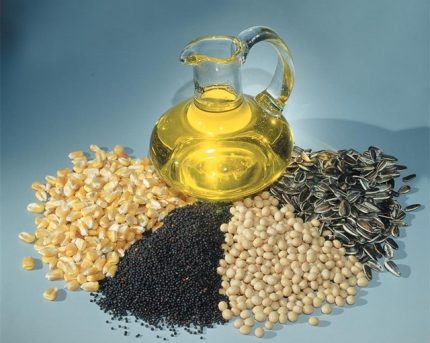
This allows you to burn this biofuel in an open device, a chimney is not needed for it. Therefore, ecofireplace - a convenient small structure - can be installed right in the middle of the room. Then you need to refuel it with biofuels in order to enjoy the warmth and comfort.
It is worth noting that pure ethanol burns with a bluish, almost colorless flame. It gives a lot of heat, but it's not interesting to watch it. Therefore, manufacturers of such fuel introduce special additives into its composition that give the flame a pleasant yellowish tint.
In addition to bioethanol itself, fuel can contain about 4% water and a small amount of additives, such as methylethicletone and bitrex.
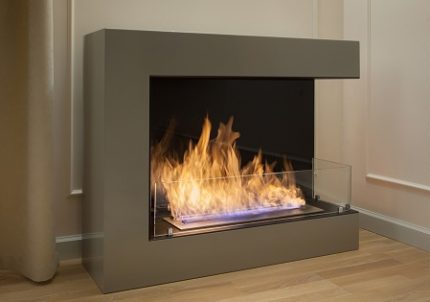
In addition, the mixture is supplemented with substances that give it an unpleasant bitter taste. Denatured ethanol is hazardous if taken orally. Bitter additives protect against accidental ingestion of the compound, although in any case, the storage rules for this dangerous compound must be observed.
Some types of fireplace biofuel are supplemented by another useful component - sea salt. This component gives the burning composition not only a pleasant color, but also a characteristic crackle.
Various flavors can also be added to bio-fuels for eco-fireplaces. Compositions supplemented with coniferous aromas are very popular. The smell of sea salt is also popular.
Ethanol is considered a neutral product in relation to nature, i.e. its production, storage and burning do no harm. In the process of burning, this substance decomposes into carbon dioxide and water, but does not emit any unpleasant odors.
When biofuel is burned, of course, a certain amount of combustion products is formed, but it is insignificant. The device that is used for burning, you just need to wipe it sometimes.

Denatured ethanol is made in the form of a liquid or gel. Liquid biofuel is supplied in cans, it must be poured into the ecofirer's designated container. The gel is available in jars that you just need to open, install in an eco-fireplace and set fire to them before use.
Sometimes two or three cans of biogel are used simultaneously to get a more beautiful flame. The contents of one container can burn for about three hours.
To extinguish the flame, just close the lid on the bank. Liquid bioethanol is poured into cans with a capacity of one to twenty liters. The tank usually has a convenient fuel consumption scale.
Such industrial production compounds are delivered from Brazil, which is considered the leader in the manufacture of this product, as well as from Europe, Canada, USA, South Africa, etc. Successfully master this technology in India and China.
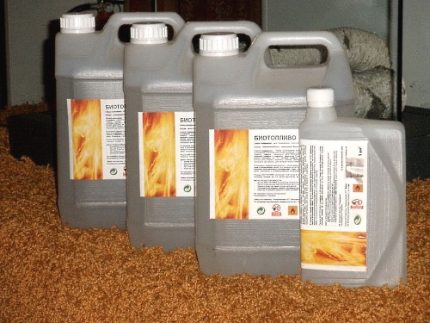
When choosing biofuels for an ecofireplace, you need to pay attention to its quality and safety. An important indicator is the amount of heat that is released during the combustion process. High-quality fuel is usually provided with certificates confirming its safety and effectiveness.
Different compositions give different flames in color and sharpness. This point also needs to be taken into account, especially if the fireplace will be used as decoration for the interior.
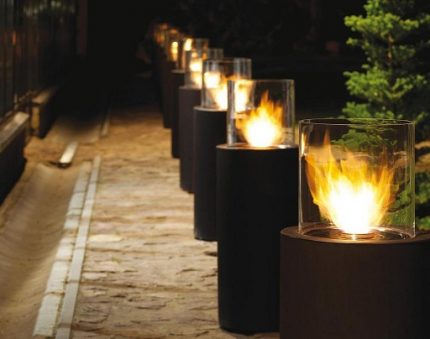
This type of biofuel is successfully used to organize street lighting. In this case, you should choose a composition that gives the brightest flame. It does not hurt to pay attention to the amount of combustion products, it should be minimal.
To store biofuels, you need to choose a place that is away from fire and heat. For ignition, special metal lighters should be used. Using regular paper matches and other similar materials can be dangerous.
Additional information on the types and selection of biofuels is presented in the articles:
- Types of biofuels: a comparison of the characteristics of solid, liquid and gaseous fuels
- How to choose fuel for a biofireplace: a comparative overview of types of fuel + analysis of popular brands
Useful information on eco-fireplaces
The device is an enlarged version of a conventional spirit lamp with a spectacular design. There is a tank for loading combustible material, as well as a shutter to regulate the intensity of the flame. To design an eco-fireplace, ceramic elements, metal parts and heat-resistant glass are used.
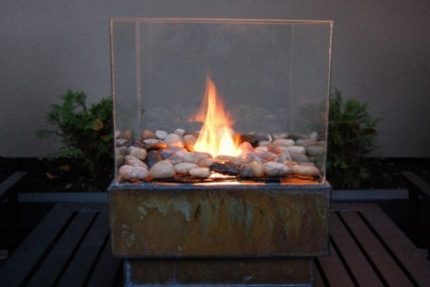
Glass panels not only decorate such a device, but also serve as protection against heat. Not all devices have this protection, but glass screens of various modifications are sold separately.
It makes sense to purchase a security element, especially if you plan to use a mobile model that will be installed in different places. Often such a fireplace is decorated with artificial wood to give the design a traditional look, but this is not the only option.
Ecofireplaces are floor, table, wall and even desktop, they vary in size, but work the same way.

Such devices can be used to heat the room or as an interior decoration. The device does not need wires, so it can be easily moved. For example, on a cool summer evening, an eco-fireplace can be installed on the open veranda. There are devices of various shapes.
An interesting option for a stylish office can be a miniature model, the camera of which is built into the countertop, only the lid protrudes above the surface. There are interesting options in the form of a basket, an elongated cylinder, etc.
Since for an ecofireplace in which such biofuel is burned, it is not necessary to equip a system for removing combustion products, the heat obtained during combustion is not lost on heating additional structures.

Therefore, it is believed that the efficiency of such a device is about 95%, a rather high indicator for any system. A half-liter of bioethanol is usually enough for an ordinary eco-fireplace to work for an hour. In this case, from a liter of fuel you can get 6-7 kW / h of energy.
It is believed that a standard eco-fireplace can successfully replace an electric heater of about three kilowatts.

The advantage of using a biofireplace in comparison with other heaters is that this device slightly increases the humidity in the room. Almost any traditional heating method, on the contrary, removes moisture, which can adversely affect people's health.
Both ecocamine and bioethanol are very easy to use, and this fuel is not more dangerous than other combustible substances used in everyday life.The burning of bioethanol can be regulated if such a possibility is provided in the design of eco-fireplaces.
The device can produce more or less heat and light, and accordingly, the time spent on fuel will also change.
This heating method also has some disadvantages. For example, with all the ease of use, bioethanol should not be added to the fireplace capacity. It is necessary not only to wait for the composition to burn out, but also to allow the device to cool. This point will have to be considered when planning the time of using the fireplace.
Although bioethanol fireplaces do not need a chimney, such devices cannot be used uncontrollably.

A room that is heated in this way needs to be ventilated regularly to balance the amount of oxygen and carbon dioxide. If a little fuel was spilled during the fueling process of the fireplace, it must be immediately erased, even if it is a couple of drops of combustible material.
To do this, it is better to keep a rag with good absorbent properties at hand. For ignition, it is allowed to use special long matches, but long metal lighters are more often used. Some biofuel fireplaces equipped with an electric ignition function, which is very convenient, but increases the cost of the model.
How to make biofuel for ecofireplace
It is not difficult to make a composition of this type on your own. To do this, you can simply buy pure alcohol, for example, in a pharmacy. If you pour it in its pure form, the flame will be almost colorless. To give it a yellow color, you need to add a little gasoline to the alcohol.
The proportion is approximately 20: 1 or 20: 2, i.e. 50-100 ml of gasoline should be taken per liter of alcohol.

Instead of alcohol, some use moonshine, but it must be very well cleaned. Mixing alcohol with gasoline must be performed immediately before pouring the composition into the fireplace.
Long-term storage of the mixture is useless and dangerous, since in a calm state the elements disintegrate into separate liquids. Mix the components very carefully.
Homemade eco-fuel can burn with a characteristic odor of alcohol, which causes unpleasant sensations. To correct the situation, you can add to the fireplace (but not in the composition) a few drops of essential oil with a pleasant smell. Typically, the aromas of needles are suitable for this, which create the illusion of burning real firewood.
The same mixture can be used for kerosene lamps, instead of kerosene. The composition does not give soot and smells much better than kerosene.
How is biogas produced?
This type of fuel differs significantly from the bioethanol described above in composition, production method and application. If desired, such a combustible substance can be produced in its own area. This gas is not suitable for an ecofireplace, but it is quite successfully used for ordinary fireplaces equipped with special burners.
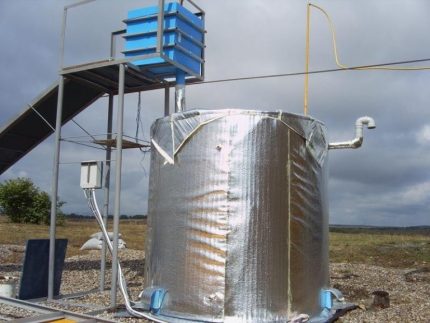
Through them, not only biogas, but also an additional stream of oxygen enters the combustion chamber. In this way, efficient biofuel combustion can be ensured. A fireplace designed to use biogas must have a chimney. This allows you to use it not only for burning gas, but also for more traditional types of fuel: firewood, coal, etc.
If the house already has a fireplace, it will not be especially difficult to convert it to biogas. If you have enough firewood, you can make charcoal yourself to save a little. Can produce biogas from manure.
It must be mixed with products of plant origin: straw, peat, tree leaves, vegetable tops, sawdust, etc. Such a mixture is placed in a tightly closed container, where it ferments under the influence of bacterial cultures.
The result is a combustible gas, which consists mainly of methane. It can be burned to heat residential premises, greenhouses, utility rooms.
One of the mandatory requirements for biogas plant - absolute tightness. Since the process is accompanied by the release of a characteristic stench, a fermentation tank is installed underground.
A hose is brought out, through which the generated gas enters. One more hose is needed to feed material for processing. A biogas generator can be made independently, but there are industrial models that are safer and more productive.
Conclusions and useful video on the topic
Useful information on bioethanol production is contained in this video:
Here you can see the process of creating the simplest eco-fireplace model:
This is how an industrial eco-fireplace looks in the living room interior:
Biofuels are a fairly broad concept. The composition option is selected depending on what type of fireplace is supposed to be used. But it is always a combustible substance, the use of which should strictly adhere to safety requirements.
Consideration of the use of biofuels should be made if only because it is produced from renewable resources.
Have something to supplement, or have questions about choosing and using biofuels for a fireplace? You can leave comments and participate in publication discussions. The communication unit is located below.

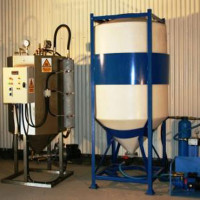 How to make biofuel with your own hands from manure at home
How to make biofuel with your own hands from manure at home  How to make a bio fireplace with your own hands: device, diagrams and step-by-step assembly instructions
How to make a bio fireplace with your own hands: device, diagrams and step-by-step assembly instructions 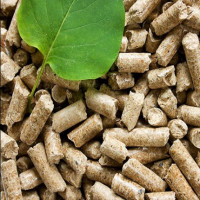 Types of biofuels: a comparison of the characteristics of solid, liquid and gaseous fuels
Types of biofuels: a comparison of the characteristics of solid, liquid and gaseous fuels 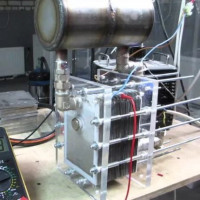 How to make a hydrogen generator for your home with your own hands: practical tips for manufacturing and installing
How to make a hydrogen generator for your home with your own hands: practical tips for manufacturing and installing  DIY bio-fireplace burner: instructions and manufacturing tips
DIY bio-fireplace burner: instructions and manufacturing tips 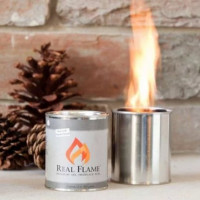 How to choose fuel for a biofireplace: a comparative overview of types of fuel + analysis of popular brands
How to choose fuel for a biofireplace: a comparative overview of types of fuel + analysis of popular brands  How much does it cost to connect gas to a private house: the price of organizing gas supply
How much does it cost to connect gas to a private house: the price of organizing gas supply  The best washing machines with dryer: model rating and customer tips
The best washing machines with dryer: model rating and customer tips  What is the color temperature of light and the nuances of choosing the temperature of the lamps to suit your needs
What is the color temperature of light and the nuances of choosing the temperature of the lamps to suit your needs  Replacement of a geyser in an apartment: replacement paperwork + basic norms and requirements
Replacement of a geyser in an apartment: replacement paperwork + basic norms and requirements
Well, here I wanted to buy such a fireplace for myself, I even found it at a good price. Actually a great thing for an apartment. In a private house, for me personally, nothing would replace a natural fireplace with soot and soot, well, that’s true. So I started looking for bioethanol by markets in Minsk. I went to all the specialized stores - nowhere. Because there is no demand yet. I found it only in one place, but the price for it is such that these “pleasant evenings by the fireplace with a characteristic crackle and yellowish color” cost me a pretty penny, unreasonably expensive. I’ll wait until it is untwisted and prices go down ...
I always wanted a fireplace, but I thought that it was rather problematic to realize it in an apartment until I found out about eco-fireplaces. This option was perfect for us - it doesn’t need a chimney, it’s quite small in itself, but it’s beautiful and really heats the room. We use biofuel in our fireplace, the fire looks almost like real, even crackles like wood.
I would not call a biofireplace a “heating device”. The thing is purely decorative, to decorate and create coziness.
You obviously have never come across bio-fireplaces in real life. Depending on the size, they can produce up to 6-7 kW of power. They may not be suitable as the main source of heating, but as an additional source it is easy.
Alexander, when it comes to choosing appliances for a heating system, power alone cannot be taken into account. Here we are talking, to a very large extent, about the feasibility and profitability of the chosen equipment. Now tell me, how much will it cost to heat a biofireplace, as a heating device, for example, per season? Given the cost of biofuels, tens of times more expensive than using any other energy source!